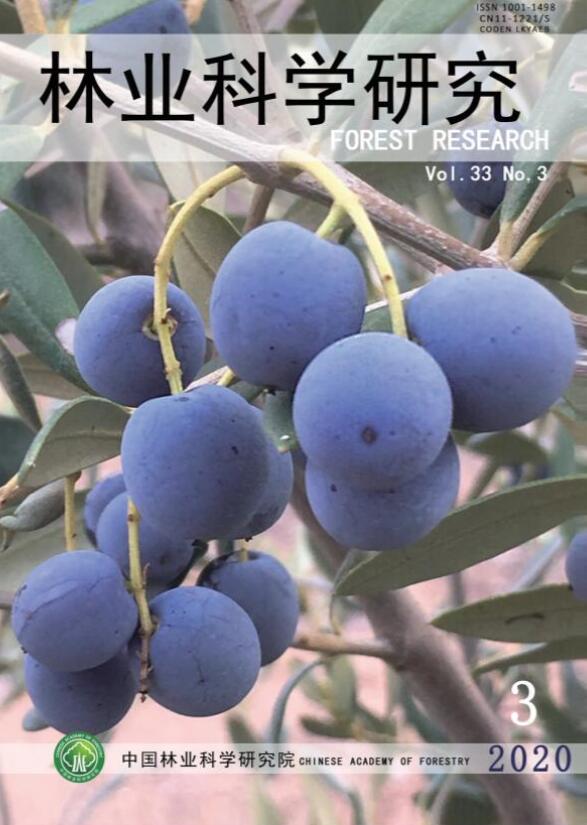-
有孔团水虱(Sphaeroma terebrans)属于甲壳纲(Crustacea)等足目(Isopoda)扇肢亚目(Flabellifera)团水虱科(Sphaeromatidae),团水虱属(Sphaeroma)。2013年以来,我国海南、广西、深圳等地陆续发生有孔团水虱造成红树林大面积死亡的事件,严重爆发可使红树林死亡面积以年均66%增长[1-2]。
目前国外团水虱主要集中在红茄冬(Rhizophora mucronata Poir.in Lam.)上,而我国遭受团水虱危害的主要树种是白骨壤(Avicennia marina (Forsk.) Vierh.)、木榄(Bruguiera gymnorhiza (L.) Lam.)、海莲(Bruguiera sexangula Lamk.)等红树种类。另外国外没有出现大面积红树林死亡的报道。在团水虱造成红树林严重危害之前,国内极少有文献报道,其生物学和防治的内容基本空白。关于有孔团水虱相关研究多数集中在其本身的生物学特征。结合我国各地的发生情况和前期的调查,整理和归纳了有孔团水虱的研究情况,以期对有孔团水虱的防治和综合治理有所帮助。
HTML
-
在中国,与红树林密切相关的团水虱种类主要是有孔团水虱和光背团水虱(S. retrolaevis)两种,两者的名称常被混淆[1-2]。但这两者对红树林造成的影响差异大,从形态上正确区分非常必要。表1是两者的主要形态差异。
特征区别Distinctive features 光背团水虱Sphaeroma retrolaevis 有孔团水虱Sphaeroma terebrans 成年个体大小Adult size 可达10 mm Up to 10 mm 可达12 mm Up to 12 mm 第 5 ~7 胸节5th to 7th thoracic segments 无凸起No bulge 各具4个凸起 Each with 4 bulges 雄性最后1对足Male last pair of feet 未骨化Not ossification 骨化Ossification 下颌骨Mandible 接近Contiguity 分开Detachment 腹部末端形态Abdominal terminal morphology 平截Truncature 近抛物线 Near parabola 蛀孔形态Wormhole form 纵向 Parallel 横向 Cross Table 1. The main difference between Sphaeroma terebrans and Sphaeroma retrolaevis
-
国外主要分布在印度、斯里兰卡、泰国、印度尼西亚、澳大利亚、巴布亚新几内亚、美国、巴西等国家。国内分布在浙江以南沿海地区,其中海南、广州和广西三省内团水虱导致红树林大面积死亡,近期深圳也有致死情况发生。
物理障碍、地理隔离、海洋环流共同影响着有孔团水虱的种群地理分布结构[3-4]。有孔团水虱的区域分布可能受一些非生物因素的影响,包括盐度、水温、悬浮物、潮汐以及浸淹的影响[5-8]。
有孔团水虱生活在红树林根系所形成的潮间带生境中[6, 9],通常在红树植物的气生根中蛀孔居住。在肯尼亚岛屿和内陆空间尺度较大的红树林,位于低潮带尤其是位于潮沟边缘或向海边缘泥质或沙质基底的红茄冬,受有孔团水虱侵扰普遍且强度大,大部分根系被毁坏或死亡,而位于高潮带的红茄冬未发现其危害的迹象[10]。有孔团水虱危害红茄冬林支柱根的强度不一,仅在垂直高度1 m范围内,死亡根和受损根所占比例不等,但气生根受损一般发生在向海一侧的低水位泥质区。在肯尼亚和桑给巴尔岛沿岸红树林区,有孔团水虱是否危害红茄冬气生根一般取决于两个因素,即水位和沉积物类型。随着潮间带高度的增加,等足类甲壳动物浸在水中的时间减少,这不仅限制了它们的觅食时间,而且减少了其侵害根的时间。而泥质底质水体中的有机物要比沙质区的丰富,因而有孔团水虱在泥质区更易获取食物[11]。潮间带的基底沉积类型、水位高度及是否临水是影响有孔团水虱丰度的主要因素[10]。
-
有孔团水虱属于甲壳动物等足类团水虱科,该科动物通常居住在热带或亚热带的红树植物的气生根中。一般来说,有孔团水虱的整个生命周期都在同一片的红树林中。Baratti等[12]对非洲和美国5个红树林生态系统的有孔团水虱进行采样分析,提供了不同地区种群之间遗传分化的明确证据:持续性低的种内变化和持续性高的种群间距离表明几乎所有的有孔团水虱线粒体的差异(细胞色素氧化酶I)体现在种群间而不是在种群内,其中平均单倍型多样性(h)是0.71%,平均核苷酸多样性(π)是0.34%;最小生成树(MST)揭示了一个复杂的模式:3个主要的单倍型类群对应的所研究地理位置分布在网络中。这表明了该种有一个悠久的进化史和种群间的基因流动受到了限制。考虑到类群相关特性,遗传分化程度并不能完全评价类群的分类地位,但在种群分支(A vs B+C=21%; A, B+C vs D=22%)的遗传分化可参考已有文献中描述的甲壳动物[12-13]。以甲壳动物来说,COI基因存在16%的差异可认定为两个物种[13]。因此,在属于不同类群种群间的核苷酸差异的百分率已经远大于同属不同物种间最小的极限[13]。Baratti等[12]认为有孔团水虱种群间大的遗传距离可以表明该分类群不是一个单一物种而是一个复杂的分类群,该类群的分类地位需重新定义。
为了了解有孔团水虱潜在的遗传分化和地理分布结构,研究人员对其开展系统地理学分析[14]。该物种在红树林根中度过其整个生命周期,具有较低的主动扩散能力且没有早期扩散阶段。由于这个物种分布于海洋,远程扩散机制(如通过浮木进行的漂流扩散)对其扩散分布是极其重要的。然而,研究人员在相邻的栖息地发现了高水平的遗传分化和低水平的基因流,与海岸地形相关的物理障碍可能有助于减少基因流。世界范围的有孔团水虱似乎不只包含一种种类。
1.1. 形态特征
1.2. 有孔团水虱的分布
1.3. 有孔团水虱的分类地位
-
对于有孔团水虱雌性来说,夏季出生的幼体可存活到次年的春季,秋季出生的幼体可存活到第二年的夏季。从整体上看,有孔团水虱2年可繁育3代,寿命较长的团水虱可存活10个月[15]。
-
有孔团水虱具育卵囊,胚胎在育卵囊内生长发育。其胚胎发育可分为5个阶段[15-16]:①受精之后,形成蛋黄状的胚胎;②卵膜脱落,肢体出现,眼睛无颜色;③胚胎伸长,肢体进一步发育,眼睛着黑色。④附肢发育,个体分隔出现,蛋黄大部分被消耗完。⑤蛋黄全部被消耗完,附肢完全伸长,胚胎形成带有软外骨骼的幼体。
有孔团水虱具外骨骼,通过换壳完成幼体的生长发育过程。目前的文献中并未查询到有关有孔团水虱换壳次数的记载,作者根据采集到不同大小的团水虱的个体分布情况,可以初步判定有孔团水虱成熟前至少经历4次换壳。有文献记述体长6.5 mm以下的虫体为未成熟个体,幼体要经历5个时期[15]。
-
有孔团水虱属于滤食性,可取食悬浮的沉积物、藻类和细菌[17-19]。由于有孔团水虱并不摄食根系和枝干组织,一般认为其与红树植物之间没有取食关系[17]。但有孔团水虱幼体以纤维素为唯一食物来源比无食物的情况下存活的更久;另外,酶分析实验结果表明,有孔团水虱的消化盲囊组织匀浆中含有活性的纤维降解酶且其后肠有纤维类似物。总的数据表明有孔团水虱具有把木材当成食物来源的能力[20]。
-
有孔团水虱完全依赖它们的下颌骨蛀孔。John实验表明,有孔团水虱成体能够在48 h内建造一个供其居住的洞穴[21];成体甚至能够在3 h内挖掘一个可供其所有子代居住的洞穴,亚成体可在48 h后建立一个洞穴,初龄幼体一般需要4 d以上的时间来建成一个洞穴,而有孔团水虱初孵幼体骨骼较软,其下颌骨和肌肉附着点不够坚硬,不能支撑其钻孔[22]。
孔洞对有孔团水虱具有重要的作用:①阻止非生物因子(暴露、干燥)和生物因子(天敌)的干扰[6];②通过腹肢的摆动,可形成水流,以便进行滤食活动;③有利于繁殖和产后恢复[15]。有孔团水虱由于蛀孔习性,对海上建筑设施的危害很大,因而造成了巨大的经济损失[18, 23]。对于蛀孔的生物学意义争议很大,有人认为等足动物会引起“生态灾难”,也有人认为等足动物的存在会给红树林带来益处[24]。这两种观点都是描述了事物发展过程中的某一状态,而这一状态的相互转变取决于团水虱的种群数量和密度变化。
Rhem和Humm指出,有孔团水虱能在24 h内钻进红树枝干内,并在几天之内就能产生大量的空洞,洞穴直径均为5 mm,这表明该入侵过程通常是由成体来完成的[9]。红树植物气生根上通常有1~3个空洞,孔洞长度小于5 cm,一般出现在距气生根根梢5 cm范围内,最常见的空洞长0.5~3 cm(平均约1.6~1.8 cm)。尤其在团水虱的生长发育后期,大量的亚成体在气生根中钻洞,造成大量的蛀孔。气生根中有孔团水虱的平均数量在秋天最高,冬季开始下降,夏季末达到最低水平。
-
处于生殖期的有孔团水虱全年可见,生殖活动高峰期一般是在秋季和春末初夏。在美国佛罗里达州发现雌性一生可产卵2次,1次是在早秋,1次是在晚冬或早春[15]。雌性1次平均可产35个胚卵[7],胚卵的数量和亲代雌虫的体长呈正相关[15]。亲代雌性(有幼虫在洞穴的雌性个体)在洞穴中养育的幼虫的平均数量在5到20只之间。在雌性个体洞穴中发现的大多数幼虫处在初龄阶段,体长在2至3 mm之间。在母洞时幼虫身体尺寸不会增大,在洞穴中还发现了相似尺寸的其他生物。
-
雌性成年团水虱有育儿袋,其中含有的有机物浓度与外部环境浓度不同,因此可作为幼虫具有渗透功能的庇护所。幼体在孵化出来之后,会在母体的洞穴中待上40 d左右,在这期间母体始终留在洞穴中,雄性并不参与对子代的照顾。有孔团水虱的这种生殖策略主要是庇护刚孵出来的外骨骼还未硬化和生理能力仍在发展的幼虫。有孔团水虱亲代对子代的照顾有利于在不利的自然条件下幼体的存活。
-
与大多数甲壳类动物不同,等足类的团水虱没有浮游幼体阶段。漂流是居住在红树林中孵卵的海洋无脊椎动物常见的传播方式[26-27],包括有孔团水虱[19]所特有的。
有孔团水虱在海洋环境中的扩散是生物体主动或被动迁移的结果。主动迁移是从原栖息地到相邻新栖息地之间的攀爬行走或游泳。被动扩散可通过红树等苗木的漂流来完成。主动迁移通常是在个体发育中某个特定生活史阶段进行的,而整个生活史阶段的个体皆易受被动扩散的影响。有孔团水虱的主动迁移主要在幼年和亚成体阶段进行,一般在栖息地周边范围活动,扩散距离有限;被动迁移时可随漂流木扩散距离较远,一旦整个生活史阶段的虫体特别是孕卵雌性个体存活下来,它们将会入侵扩散新栖息地并成功定殖。
-
Howey和Estervez提出有孔团水虱具有强烈的趋固性;一旦失去庇护所,它们会立即寻求一个基底来修建洞穴[6, 28]。John认为有孔团水虱具有负趋光性,这种行为与实验结果一致,有孔团水虱会将洞穴定于某些物体下面避光[22]。另外,有人发现用受伤的小动物可以诱捕到有孔团水虱[29],这可能是动物体上散发出来的某种物质对有孔团水虱有吸引作用。
关于有孔团水虱穴居偏好的文献鲜有,但是John表示,它们更喜欢钻蛀“预先柔化”的木材[22];Estervez和Santhakumari发现,有孔团水虱会寻找红树林支柱根上的瘢痕或伤口来进行钻蛀[6, 30]。有孔团水虱在美洲红树的气生根上定居时对根尖区域(即根上最幼嫩部分)有着强烈的偏好,特别是深根[31]。
-
Kumari等首次记录了团水虱洞中的7种外共生体纤毛虫,即钟虫 Vorticella contpanida、聚缩虫Zoothamnium rigidum、Cothurnia gammari、Legenophrys cochinensis sp. Nov.、累枝虫Epistylis Gammari、Folliculina producta和Foliculina boltoni[32]。我们在广西和海南的有孔团水虱洞穴中除发现纤毛虫外,还常发现钩虾的存在。
2.1. 生活史
2.1.1. 年生活史
2.1.2. 生长与发育
2.2. 生活习性
2.2.1. 取食行为
2.2.2. 钻孔行为
2.2.3. 产卵行为
2.2.4. 孵育行为[25]
2.2.5. 扩散方式
2.2.6. 趋性和偏好
2.2.7. 外共生体纤毛虫
-
等足类动物通过蛀孔可减少根系的形成并加快根系的萎缩[33],使红树根系的结构发生变化,从而直接对红树造成损伤[34-35]。同样的,有孔团水虱的蛀孔可减缓根的生长速度,加快根尖的萎缩[8, 33, 36-37]。等足动物蛀孔导致的根系变化不仅改变了树的结构支持和营养供应[10],而且还可能间接影响到利用底质洞穴作为基底[37-40]或保护性生境[41]的其它动植物。因此,特定区域内有孔团水虱分布产生的影响往往是群落范围内的。树木质量上的差异,如根系结构(例如根茎、根须)、根的渗透性、含水量、洞穴的完整性或化学性质,可能使一些红树林群丛不适于有孔团水虱的居住。如上文1.2所提到的,泥质基底、平均水位以下、向水面的红树林根系易遭受有孔团水虱的侵蚀,易造成红树林的萎缩;根据有孔团水虱秋天数量最高可推断出其对红树林的危害在秋天较大。
在佛罗里达有孔团水虱通过蛀孔于红树支柱根、气生根和胚轴等,引起大量红树植物倒伏,造成红树林的大面积的萎缩,并严重影响着红树林的扩张[9]。近年来国内红树林遭到有孔团水虱和光背团水虱的侵扰。2013年海南东寨港红树林保护区内团水虱的危害面积达33.3 hm2,死亡面积为5.39 hm2,100多万株红树消失[42]。在广西北海草头村和银滩遭受有孔团水虱破坏的红树林面积为2.33 hm2,死亡面积0.50 hm2[2]。
有孔团水虱蛀孔活动产生的有利影响和有害影响均有报道。有人提出其蛀孔活动会增加气生根的旁侧分支发育而有利于红树生存[34];但这一观点遭到怀疑,有孔团水虱对红树植物生长速率的影响较大,其根系净产量比未蛀孔根的低62%[43]。在红树林中,蛀孔活动会导致气生根组织受损,有利于有害真菌的侵入,进而使气生根遭受更大的损伤[44]。
-
红树经由受伤部位周围组织新生众多侧根把能量分流,或者通过修复取代受伤根系组织[34],从而对蛀孔所引起的组织损伤做出响应[45]。红树对蛀孔最普遍的反馈是修复空的蛀孔,99%的气生根与66%的蛀孔有被修复的迹象,产生侧生根的频率(32%)较低[46]。在坦帕海湾上湾、安娜玛丽亚岛和威登岛的调查结果显示57%~82%的被蛀气生根蛀孔具修复现象,而产生侧根的现象同样是比较少见(13%~25%)。但产生侧根与蛀孔修复之间并不相互排斥,在每个新生侧根过程中都伴随着蛀孔修复产生。结果表明红树对损害最普遍的响应是修复组织而不是产生新组织[46]。
3.1. 有孔团水虱对红树林的危害
3.2. 红树林对团水虱响应
-
某些海绵和海鞘对有孔团水虱来说是有毒生物。许多海绵(包括苔海绵和蜂海绵)和一些海鞘能够产生多种结构防御系统[47]和化感物质[48-51],这些化感物质对有孔团水虱等多种海洋生物都具有较强毒性。如果等足类动物无法穿透这类体表寄生生物,或者体表寄生生物使红树林根部隐藏起来,那么这些海绵和海鞘类可作为物理屏障来阻止等足类动物的定殖。相比于未被附着的双壳贝类,被海绵和海鞘所覆盖的牡蛎[52]和蛤[53]更少被捕食,有助于寄主的隐蔽。
常见的具壳表栖生物能够阻止等足类甲壳动物危害大西洋西侧红树林幼根。当表栖生物或天敌丰度不高时,等足类动物严重危害红树林根系。在伯利兹南部沿岸河口处,有孔团水虱对红树林气生根破坏约达到了100%[33]。这些河口的红树林里缺乏浅海底栖动物,等足类动物的天敌鲜少。表栖生物与滤食动物之间复杂的相互作用关系也成为红树林生态系统结构持久性的重要决定因素。
在团水虱危害程度不同的红树林中,支柱根上的污损生物无明显差异,且在其他生物附着或危害后,团水虱可以迅速地在新根上定殖[31]。有学者建议采用牡蛎、藤壶阻止等足类动物的定殖[5],但牡蛎、藤壶同时会对根系造成损伤[6]。
Perry发现,腹足类如蟹守螺(Cerithium sp.)、波褶岩螺(Thais kiosquiformis)、Morula lugubris和寄居蟹(Clibanarius panamensis)均可捕食有孔团水虱,能够减少后者对红树林0~75 cm高度的根系的侵袭[36]。
鱼类一般不捕食蛀孔中的团水虱,但能取食游泳或停留蛀孔外的团水虱;生活在红树树干基部孔洞或缝隙中的鳚鱼有较大机会捕食团水虱,取食试验证实栖息在红树林里的底栖鱼类中华乌塘鳢(Bostrichthys sinensis)能够取食团水虱[2],另外我们在红树林潮沟里的鰕虎鱼肠道中也发现了团水虱。
研究人员还提出了食肉海葵通过捕食有孔团水虱从而防止其侵袭红树林根系的假设[33]。然而该团队在海葵的肠道中并未发现有孔团水虱的残体,并且在控制投喂实验中海葵拒食团水虱[33]。因此布朗海葵无法避免根系免受有孔团水虱的侵袭。
捕食行为虽然可以影响物种的分布,但不同于红树林根系体表的污损生物(如藤壶和腹足类),有孔团水虱居住在洞穴中,且不存在易受攻击的浮游阶段,只在掘洞前期才易被捕食,这大大减少暴露给捕食者的几率。仅一个潮汐周期有孔团水虱就可挖出一个较深的洞穴,在此过程中仅其背部暴露于外[31]。到目前为止没有文献记录有以有孔团水虱为主要食物的专一捕食者,因而捕食压力的重要性仍受到质疑[31]。
-
有孔团水虱无浮游幼体阶段,其整个生活史几乎全部在洞穴中度过,加之其天敌较少,这些导致有孔团水虱的有效防治途径较为匮乏。
国外关于团水虱防治的研究较少。Cragg团队提出化学处理和防腐剂会影响等足类动物的定殖[23]。Huynh等表明拟除虫菊酯类杀虫剂对等足类动物是有害的[54]。Roshaven发现,极端高温和极高盐度的单独或组合使用都可限制成年有孔团水虱的生存[55]。经铜铬砷或杂酚油表层涂层处理的木材,可以有效控制咀虫,在某些情况下也可以有效控制蛀木水虱和团水虱。团水虱的种群数量控制和健康的红树林群落可能是控制它们的关键。
我国防治研究相对较多。2013年以来,海南东寨港红树林保护区团水虱爆发成灾后,部分科研单位相继开展了红树林团水虱的防治研究工作,进行了有意义的技术探索并陆续申请了有关的发明专利(表2),积累了一定的防治经验。
专利发明人
The patent inventor专利名称
Patent专利简要说明
Brief description of patent何雪香,等[56]
He et al《防控团水虱的双重药剂及应用该药剂防控团水虱的方法》《The double agent for the control of and Sphaeroma sp. and the method for the control of the isopoda》 配制化学药剂进行涂抹Prepare chemicals to apply 刘文爱,等[57]
Liu et al《一种红树林团水虱虫害的防治方法》《The method for controlling Sphaeroma sp. of mangrove forest》 利用食盐进行涂抹或喷洒Apply or spray with salt 管伟,等[58]
Guan et al《一种快速防治团水虱的烟剂、烟熏装置和方法》《The invention relates to fumicant、a fumigating device and a method for rapid control of Sphaeroma sp.》 配制烟剂进行烟熏Smudging with The fumigant 吕晓波,等[59]
Lv et al《一种运用隔离原理治理红树林团水虱危害的物理防治方法》《A physical prevention method for using the principle of isolation to control the damage of mangrove Sphaeroma sp.》 使用塑料薄膜将团水虱物理隔离Use plastic film to physically separate the Sphaeroma sp. 黄勃,等[60]
Huang et al《防治团水虱和船蛆钻孔海洋生物的药物及其使用方法》《Medicine and method for controlling marine organisms Sphaeroma sp. and shipworm》 配制药剂进行涂抹,并涂上桐油隔离Applying medicaments to control and tung oil to segregation 刘文爱,等[61]
Liu et al《一种利用二氧化氯防治红树林团水虱虫害的方法》《A method to control mangrove Sphaeroma sp.by chlorine dioxide》 配制高浓度二氧化氯溶液进行喷洒Spraying high concentration chlorine dioxide to control Table 2. Related patent application for the control of mangrove Sphaeroma sp. in China
当前的团水虱防治专利主要集中在团水虱生物体的灭杀上,需要每木处理,不便操作、成本较高;防治技术手段不能从根本上解决团水虱的危害问题,对当地红树林生态环境也存在着一些不利的影响,因而需要继续研究探索更高效、环保的技术手段。
造成红树林团水虱灾害爆发原因是多方面的,通过研究寻找共性规律,揭示团水虱爆发的机理,为团水虱的科学治理提供科学基础;将团水虱监测纳入红树林生态监测体系中,鉴于其巨大的破坏作用,迫切需要研发红树林团水虱的灾害预警技术;重视团水虱灾后的红树林恢复重建,一方面需要通过人工造林恢复红树林的种群数量,另一方面是对大量受损退化红树植株的复状抚育。
团水虱个体较小,各种类的形态类似,体色容易受环境影响而有所不同,急需通过分子生物学的方法,通过基因测定加强有孔团水虱的鉴定,物种间的变异的研究。
有孔团水虱的爆发与红树林周边环境密切相关,指向性强,易于观测,是衡量红树林生态系统是否健康的重要指标。此外,由于团水虱链接了环境改变—红树林退化—红树林生态系统崩溃,因此在方法论上有孔团水虱是一个研究生态环境改变与自然生态系统演化关系的自然模板。





 DownLoad:
DownLoad: